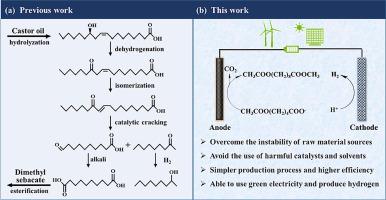Chemical Engineering Journal ( IF 13.3 ) Pub Date : 2023-12-23 , DOI: 10.1016/j.cej.2023.148331 Linchuan Cong , Yupeng Wu , Nan Lin , Xinxin Li , Fangbing Liu , Fuyu Han , Jin Yang , Ciduo Wang , Haibo Lin

|
Dimethyl sebacate is an essential organic chemical, yet its conventional high-temperature pyrolytic synthesis process is marked by complexity, energy intensity, environmental pollution, and volatile raw material supplies. Presently, electrochemical synthesis emerges as a promising, environmentally sustainable method for one-step dimethyl sebacate synthesis via anodic decarboxylation coupling with monomethyl adipate. However, the existing process falls short in achieving the desired selectivity and current efficiency, particularly when operating at high current densities, thus impeding its broader industrial adoption. This study, synergizing density functional theory computations with experimental methods, conducts a comprehensive multidimensional analysis of the electrochemical performance at high current densities across four distinct electrode types: Pt plate, RuO2/Ti, PbO2, and graphite electrodes. It underscores the strong electron-orbital hybridization between adsorbed monomethyl adipate and the platinum electrode, resulting in an enhanced propensity for electron transfer at the electrode interface and facilitating the decarboxylation of monomethyl adipate coupling into dimethyl sebacate. Subsequently, through single-factor experiments and response surface methodology, an exhaustive analysis of the various factors influencing the electrolysis process is conducted, including supporting electrolyte, current density, H2O content, neutralization, and monomethyl adipate concentration. The optimal electrolysis operation configuration offers a robust theoretical foundation and technical framework for the large-scale implementation of green, energy-efficient electrochemical synthesis technology for dimethyl sebacate in industrial settings.
中文翻译:

高电流密度下通过 Pt 电极促进己二酸单甲酯偶联至癸二酸二甲酯的脱羧
癸二酸二甲酯是一种重要的有机化学品,其传统的高温热解合成工艺复杂、能耗高、环境污染、原料供应不稳定。目前,电化学合成已成为一种有前景、环境可持续的方法,通过阳极脱羧与己二酸单甲酯偶联一步合成癸二酸二甲酯。然而,现有工艺在实现所需的选择性和电流效率方面存在不足,特别是在高电流密度下操作时,从而阻碍了其更广泛的工业采用。这项研究将密度泛函理论计算与实验方法相结合,对四种不同电极类型(Pt 板、RuO 2 /Ti、PbO 2和石墨电极)在高电流密度下的电化学性能进行了全面的多维分析。它强调了吸附的己二酸单甲酯和铂电极之间的强电子轨道杂化,导致电极界面处电子转移的倾向增强,并促进己二酸单甲酯偶联脱羧成癸二酸二甲酯。随后,通过单因素实验和响应面法,对影响电解过程的各种因素进行了详尽的分析,包括支持电解质、电流密度、H 2 O含量、中和度和己二酸单甲酯浓度。最佳电解操作配置为癸二酸二甲酯绿色节能电化学合成技术在工业环境中大规模实施提供了坚实的理论基础和技术框架。











































 京公网安备 11010802027423号
京公网安备 11010802027423号